‘The Return of the Panther’ engenders meaningful discussions among people of diverse viewpoints
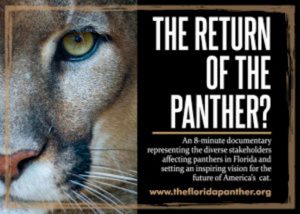 Among the noteworthy documentaries being shown this year by the Fort Myers Film Festival is The Return of the Panther by Oscar Jose Corral. It focuses on the status of the Florida Panther, which was chosen in 1982 as Florida’s state animal by a vote of students throughout the state.
Among the noteworthy documentaries being shown this year by the Fort Myers Film Festival is The Return of the Panther by Oscar Jose Corral. It focuses on the status of the Florida Panther, which was chosen in 1982 as Florida’s state animal by a vote of students throughout the state.
“Once on the verge of extirpation in the state, Florida’s panther population has been steadily increasing since a genetic  restoration effort was carried out in the 1990s,” states the documentary’s filmmaker Oscar Jose Corral. “The natural systems we depend on do better with top predators, yet living with predators is a complex issue requiring meaningful discussions between people of diverse viewpoints – like those represented in this 8-minute video.”
restoration effort was carried out in the 1990s,” states the documentary’s filmmaker Oscar Jose Corral. “The natural systems we depend on do better with top predators, yet living with predators is a complex issue requiring meaningful discussions between people of diverse viewpoints – like those represented in this 8-minute video.”
However, the numbers reported by Florida Fish and Wildlife Conservation Commission (FWC) to Florida Weekly in 2017 do not really support the claim that the 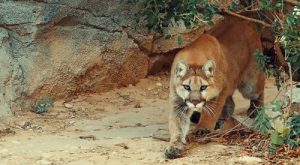 Florida panther population has been steadily increasing since the genetic restoration effort.
Florida panther population has been steadily increasing since the genetic restoration effort.
The initiative cited by the film was implemented following a 1992 population viability analysis that made the dire prediction the Florida panther would become extinct in 24-63 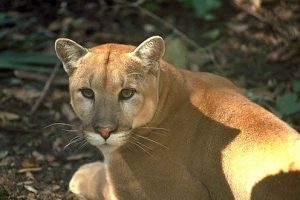 years due to its small population size and associated inbreeding. To reduce the occurrence of inbreeding, restore genetic variability and vitality, and restore genetic diversity levels to that typical of other puma subspecies, 8 female pumas from Texas (the closest living relative to the Florida panther) were released throughout Florida panther range in
years due to its small population size and associated inbreeding. To reduce the occurrence of inbreeding, restore genetic variability and vitality, and restore genetic diversity levels to that typical of other puma subspecies, 8 female pumas from Texas (the closest living relative to the Florida panther) were released throughout Florida panther range in 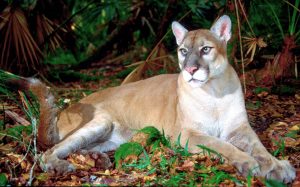 South Florida in 1995.
South Florida in 1995.
Five of the eight Texas pumas produced offspring, but that was sufficient to reestablish a healthy and diverse Florida panther gene pool and reduce the frequency of inbreeding depression indicators such as atrial septal defects (holes in the heart), cryptorchidism (undescended testicles), kinked tails and 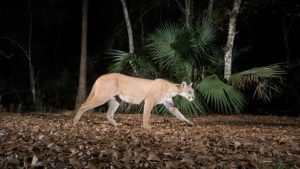 cowlicks. Population estimates increased from 30-80 to 80-100 adults. But the size of the Florida panther population has not increased much over the past 20 years.
cowlicks. Population estimates increased from 30-80 to 80-100 adults. But the size of the Florida panther population has not increased much over the past 20 years.
FWC told Florida Weekly in January of 2017 that based on radio collars, hired trackers and other information, there remain as 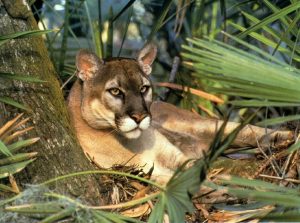 few as 100 and no more than 180 Florida Panthers in the wild. [Williams, Roger, “Panthers continue to lose in fight against traffic,” Florida Weekly (Vol. X, No. 41, Jan. 18-24, 2017.)] In fact, the number of panthers has actually declined over the past few years. In 2016, for example, only 14 cubs were born in a total of six litters, but 42 panthers died that year (34 as a result of motor
few as 100 and no more than 180 Florida Panthers in the wild. [Williams, Roger, “Panthers continue to lose in fight against traffic,” Florida Weekly (Vol. X, No. 41, Jan. 18-24, 2017.)] In fact, the number of panthers has actually declined over the past few years. In 2016, for example, only 14 cubs were born in a total of six litters, but 42 panthers died that year (34 as a result of motor 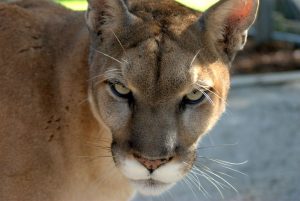 vehicles, including 16 females (up from 30 vehicle-related panther deaths in 2015 and 24 in 2014)), producing a discouraging 42:14 death-to-birth ratio.
vehicles, including 16 females (up from 30 vehicle-related panther deaths in 2015 and 24 in 2014)), producing a discouraging 42:14 death-to-birth ratio.
The Florida Panther has been on the federal endangered species list since 1967 and on the state’s endangered 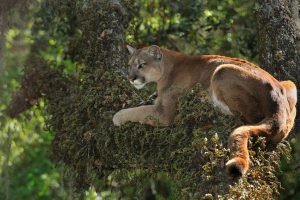 list since 1973. But it actually became illegal to hunt the big cats in Florida in 1958.
list since 1973. But it actually became illegal to hunt the big cats in Florida in 1958.
At one time, these elusive large cats (which also go by the names of “catamounts” and “painters”) ranged as far west as Texas and Arkansas and as far north as Tennessee and South Carolina. Today, 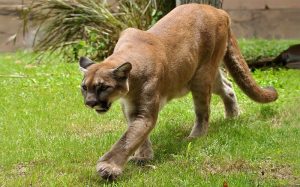 the panthers have lost roughly 95% of their historic habitat, and their current range is squeezed into a handful of protected areas in Southwest Florida such as Big Cypress National Preserve, the Florida Panther National Wildlife Refuge, and some private lands. But even here, the vitality of their habitat is undermined loss of vegetation and prey
the panthers have lost roughly 95% of their historic habitat, and their current range is squeezed into a handful of protected areas in Southwest Florida such as Big Cypress National Preserve, the Florida Panther National Wildlife Refuge, and some private lands. But even here, the vitality of their habitat is undermined loss of vegetation and prey 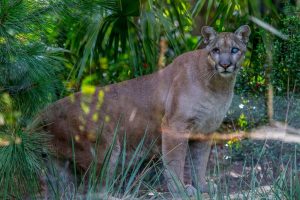 resulting from drought, wildfires and salt water intrusion. [The latter is a complication connected to sea level rise and the interruption of the flow of water from Lake Okeechobee into the Everglades, a situation that is further exacerbated by the presence of Tamiami Trail.]
resulting from drought, wildfires and salt water intrusion. [The latter is a complication connected to sea level rise and the interruption of the flow of water from Lake Okeechobee into the Everglades, a situation that is further exacerbated by the presence of Tamiami Trail.]
It’s not just  that housing developments, commercial construction and roadbuilding continue to encroach upon the panthers’ few remaining population areas. They cut them off from one another. As males and breeding pairs roam between these fragmented environments to hunt and mate, they risk being hit and killed by
that housing developments, commercial construction and roadbuilding continue to encroach upon the panthers’ few remaining population areas. They cut them off from one another. As males and breeding pairs roam between these fragmented environments to hunt and mate, they risk being hit and killed by 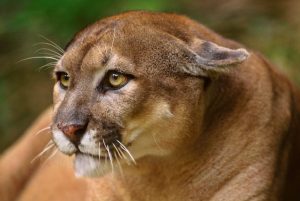 motorists.
motorists.
A number of other factors militate against the viability of the panther as a species. Their lifespan in the wild is only about 12 years, litters only range in size from one to four cubs, and breeding pairs require 200 square miles of habitat to roam and hunt. But inbreeding still remains a significant 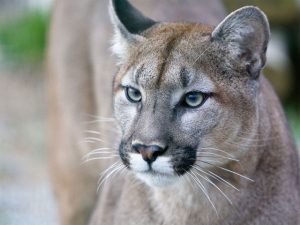 challenge.
challenge.
Because the Florida panther population remains isolated it will likely become necessary to enrich the population, as before, by releasing females from other populations at some point in the future. Scientists are carefully monitoring the population to determine when this becomes necessary. However, the survival and recovery of the Florida panther is clearly 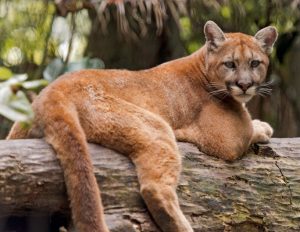 dependent upon protection of the small, remaining population, its habitats and prey resources.
dependent upon protection of the small, remaining population, its habitats and prey resources.
The Florida Fish and Wildlife Conservation Commission is responsible for management and preservation of this endangered State Animal. The future of this large animal depends entirely on the management decisions that FWC makes today and in the future on its behalf.
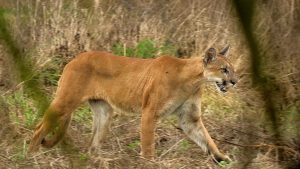 On October 22, 1988, the City of Fort Myers Beautification Advisory Board commissioned an installation titled The Florida Panther to draw attention to the plight of this “highly-endangered species. Created by North Fort Myers sculptor Don D.J. Wilkins, the 50-foot-long artwork is located in the median on Monroe Street in downtown Fort Myers
On October 22, 1988, the City of Fort Myers Beautification Advisory Board commissioned an installation titled The Florida Panther to draw attention to the plight of this “highly-endangered species. Created by North Fort Myers sculptor Don D.J. Wilkins, the 50-foot-long artwork is located in the median on Monroe Street in downtown Fort Myers 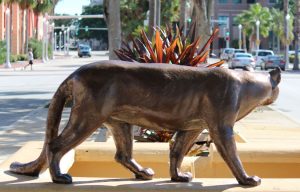 outside of the newly-refurbished Caloosa Sound Convention Center and just steps south of Uncommon Friends.
outside of the newly-refurbished Caloosa Sound Convention Center and just steps south of Uncommon Friends.
The Return of the Panther screens at 2:00 p.m. on Sunday, October 25 in the Sidney & Berne Davis Art Center.
October 16, 2020.














 Tom Hall is both an amateur artist and aspiring novelist who writes art quest thrillers. He is in the final stages of completing his debut novel titled "Art Detective," a story that fictionalizes the discovery of the fabled billion-dollar Impressionist collection of Parisian art dealer Josse Bernheim-Jeune, thought by many to have perished during World War II when the collection's hiding place, Castle de Rastignac in southern France, was destroyed by the Wehrmacht in reprisal for attacks made by members of the Resistance operating in the area. A former tax attorney, Tom holds a bachelor's degree as well as both a juris doctorate and masters of laws in taxation from the University of Florida. Tom lives in Estero, Florida with his fiancee, Connie, and their four cats.
Tom Hall is both an amateur artist and aspiring novelist who writes art quest thrillers. He is in the final stages of completing his debut novel titled "Art Detective," a story that fictionalizes the discovery of the fabled billion-dollar Impressionist collection of Parisian art dealer Josse Bernheim-Jeune, thought by many to have perished during World War II when the collection's hiding place, Castle de Rastignac in southern France, was destroyed by the Wehrmacht in reprisal for attacks made by members of the Resistance operating in the area. A former tax attorney, Tom holds a bachelor's degree as well as both a juris doctorate and masters of laws in taxation from the University of Florida. Tom lives in Estero, Florida with his fiancee, Connie, and their four cats.